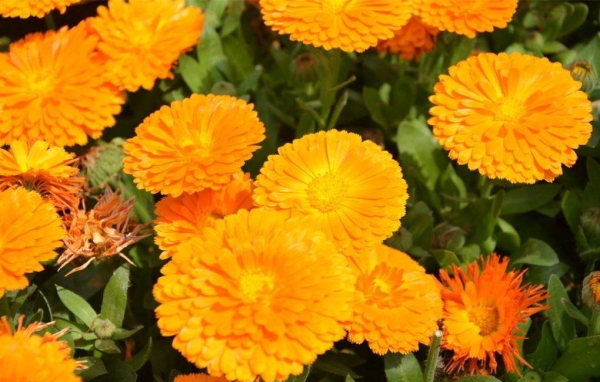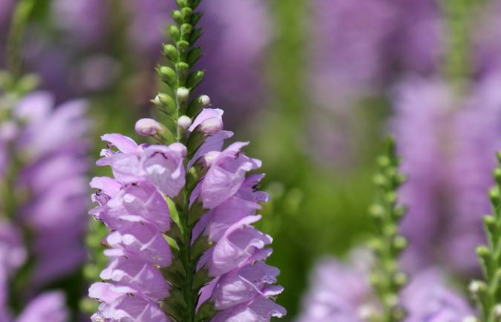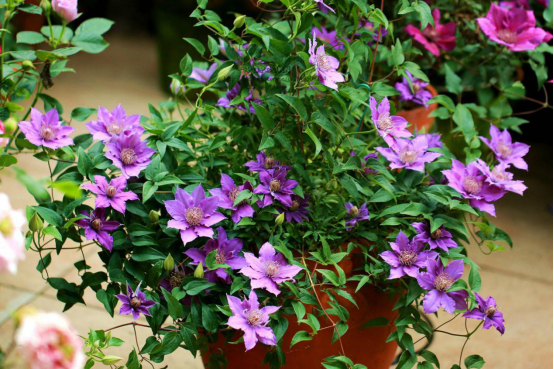Culture method of Calendula
Soil
The marigold is not strict with the soil and likes to grow in the fertile alkaline sandy soil with good drainage. The PH value of the soil should be about 6-7. The soil is fertile enough to ensure that the marigold is more branched and blossoms.
Light
Marigolds like to grow in a sunny environment, but they must not be kept in a high temperature environment in summer. If the temperature is too high, it is easy to lead to slow growth and semi-dormancy.

Temperature
The suitable temperature for marigold growth is 15 to 25 degrees, it is not resistant to frost, it will obviously grow poorly when the temperature is too high in summer, and it will go into dormancy or death when the temperature is too low.
Fertilizer application
Coring measures should be taken 7-10 days after the marigold is planted, which can promote the marigold to be more branched and spray the leaf surface of the marigold 1-2 times with 0.4% solution to adjust the plant height of the marigold. Calendula peanuts are fertilized once every semimonthly for a long time, and the fertilizer is sufficient, which can make calendula blossom more and bigger.
Have you all learned the above breeding methods? Do you know what the marigold can do?
Marigold-picture of marigold | Culture method of marigold marigold (scientific name: Calendula officinalis), also known as marigold, everlasting chrysanthemum, golden bell flower, Catharanthus roseus, marigold, etc., belongs to the genus Calendula of Compositae. Annual or perennial herbs, which like light and are not strict with the soil, can grow well in dry, loose and fertile alkaline soil, and are often used in flower beds. Culture method of Calendula
1. Soil: do not choose soil, sandy loam or culture soil with fertile, loose and good drainage is suitable, and the best soil pH is 6-7. In this way, the plant has many branches and blossoms.
2. Sunshine: the three seasons of spring, summer and autumn need to be maintained in shade. When the temperature is higher (the daytime temperature is above 25 ℃), if it is maintained in direct sunlight, the leaves will obviously become smaller, the branches will shorten, the foot leaves will yellowing and fall off, and the growth will be very slow or enter a semi-dormant state. It is necessary to give direct sunlight in winter to facilitate photosynthesis and the formation of flower buds, flowering and fruiting.
A collection of pictures of calendula
1. Ornamental value: calendula is suitable for central square, flower bed and flower belt arrangement, and can also be used as lawn edge flowers or potted plants. Long-stalked large flowers can be used for cut flowers.
2. Purify the air: calendula has strong resistance to sulfur dioxide, cyanide and hydrogen sulfide. It is an excellent anti-pollution flower, and it is also the main material of spring flower bed. It can be used as cut flower and pot plant.
The function of Calendula
The function of calendula: 1. Ornamental. Calendula rich in color, gorgeous, suitable for the central square, flower beds, flower belt layout, can also be used as lawn edge flowers or potted ornamental, ornamental effect is relatively large.
The function of calendula: 2, purify the air. Calendula has a strong ability to resist sulfur dioxide and is also resistant to cyanide and hydrogen sulfide. for excellent anti-pollution flowers, potted plants planted in homes or planted in courtyards and roadside flower beds can play a certain role in improving the air.
The efficacy and function of Calendula
Calendula plants are short and dense, with light yellow, orange red, yellow and so on. They are common herbaceous flowers in early spring garden, suitable for central square, flower bed, flower belt layout, and can also be used as lawn border flowers or potted plants. Varieties with long stalks and large flowers can be used to cut flowers.
Calendula has strong resistance to sulfur dioxide and certain resistance to cyanide and hydrogen sulfide. It is an excellent anti-pollution flower and the main material of spring flower bed. It can be used as cut flowers and potted plants. Calendula is rich in a variety of vitamins, especially vitamin An and vitamin C, can be eaten in almost every part, and its petals have cosmetic functions. Flowers contain carotenoids, tomato hydrocarbons, butterfly plum flavin, jade yellow, volatile oil, resin, mucus, malic acid and so on. Roots contain bitterness, artemisia East glycol; seeds contain glycerides, waxy alcohols and alkaloids. Put it in shampoo to lighten the hair color.
Jinzhan Chrysanthemum language
Calendula words: sadness, jealousy, parting pain, infatuation, lovelorn and sadness
Calendula looks magnificent and colorful, it represents: sadness, farewell, infatuation, disappointment, parting pain. Lovelorn let you, parting people, depressed people are the most suitable for such flowers. Calendula also symbolizes noble feelings and is a symbol of a gentleman, so if you think that a person is worthy, generous and responsible, then calendula is also very suitable for him.
Calendula chrysanthemum tea
Efficacy of Calendula Chrysanthemum Tea:
1. Marigold chrysanthemum is sweet, clear damp-heat and cool fire. It has the effect of relieving pain and promoting wound healing, helping to treat stomachache and gastric ulcer, anti-inflammation, sterilization, promoting blood circulation, relieving menstrual pain, diuresis and reducing fever when drinking when you have a bad cold.
2, rich in mineral phosphorus and vitamin C, treat insomnia, reduce anxiety and neurasthenia. Vision protection, lymphadenitis, intestinal machine can maintain / nourish liver and eyesight, beauty, detoxification and anti-inflammation.
3, can reduce menstrual pain, relieve menstrual pain, stimulate bile secretion, decompose fat, it is suggested that women might as well drink more. It has excellent curative effect on peptic ulcer and lymphadenitis. It has excellent curative effect in the treatment of peptic ulcer and lymphadenitis.
Related encyclopedia
Pocket scale non-woven bag lantern bamboo shoots crab feet red rice note3ykk zipper ybs zipper mountain cherry climbing wall plum field decision tomorrow winter plum green pine watch omega Longine watch children's building blocks rhododendron roll stick fruit Annona
Culture method of Calendula
Calendula, also known as Calendula, Golden Calendula. Herbs of Compositae in 2012.
Morphological characteristics: the height of the plant is 2030, and the whole plant is tomentose. Leaves alternate, oblong to Obovate-oblong, entire or inconspicuously serrate. Inflorescences capitate, solitary, flowers 4-8 0-1 in diameter, ligulate flowers yellow or orange, tubular flowers yellow or purple. Achenes bend. There are many cultivated varieties.
The growth habit originates from the southern European Canary Islands to the Mediterranean coast of Iran. The nature is more hardy, the Yangtze River valley can overwinter in the open field, Xi Yang is slightly resistant to overcast. It has strong adaptability and lax requirements on soil, but the loose and fertile soil grows better and is easy to self-sow and reproduce.
The propagation method is often used for sowing and propagation, usually for biennial cultivation. Autumn sowing in East China is in the first and middle of September, and seedlings emerge 7-10 days after sowing according to the conventional method. When the seedlings grow 4-5 true leaves, they should be planted separately, and they can survive the winter in the open field. Calendula grows fast and its leaves are hypertrophic. If the nursery overwinters, it should be planted in time in the next spring. Annual cultivation is often sown in early July and can blossom in autumn. The seed viability of Chrysanthemum morifolium was 3-4 years.
The cultivation and maintenance of Chrysanthemum morifolium has strong adaptability, fast and robust growth. Autumn sowing seedlings can be planted or pot when they grow 5 or 6 true leaves after transplanting or interseedling. Potted seedlings in East China are mostly cultivated in facilities or in a southward closed balcony. Topdressing is applied once or twice before overwintering after planting, compound fertilizer is applied every 7 to 10 days after growth in early spring, flowers begin in late March, flowers bloom in early May, and abortive flowers should be removed in time after flowering. It can keep blooming continuously, and it usually shows poor growth due to high temperature after the beginning of summer in June and July. Summer sowing seedlings blossom from September to October after timely transplanting and planting. The maintenance requirements of summer sowing seedlings are the same as those of autumn sowing seedlings, except that there is no need to prevent cold, but attention should be paid to fertilizer and water management during summer.
The control of powdery mildew by diseases and insect pests is the main disease of calendula, which is mostly in the leaves and stems, and white powdery spots appear at the initial stage of the disease, and finally develop into a white powder layer on the leaf surface, leaf back and stem, which causes the plant to stop growing. and lead to yellowing and death. The disease is easy to occur under the dry condition of 20: 241, and it spreads very fast, and it is also easy to occur in overgrown plants. Control methods: 0 remove diseased leaves and diseased plants and destroy them. At the initial stage of the onset of ②, the patients were sprayed with 15 "trimethoprim wettable powder 1 000 times or 20 ^ methyl topiramate wettable powder 1 000 times.
. For horticultural use, calendula is more hardy. It can blossom in early spring and is often used for flower bed arrangement. It can also be cultivated in greenhouse as potted lantern flowers or cut flowers. It can also be used to cultivate self-propagating wild flowers on the side of the house.
- Prev

How is the casual grass raised?
Soil casual grass does not have high requirements for soil, but it is best to choose loose, breathable and fertile sandy soil. Because planting on the ground should have a thick soil layer, but if you plant in a flowerpot, you can choose loose, breathable and well-drained soil. Grass likes sunshine very much.
- Next

Clematis cuttage steps:
1. For the selection of branches, we should try to choose the relatively tender ones, which are not completely Lignified. Young shoots are easier to take root and sprout. 2. Cut the branches short and place them in vitamin B solution for two hours. After taking them out, apply some rooting powder slightly. 3. Insert the branches into the nursery box with perlite
Related
- Fuxing push coffee new agricultural production and marketing class: lack of small-scale processing plants
- Jujube rice field leisure farm deep ploughing Yilan for five years to create a space for organic food and play
- Nongyu Farm-A trial of organic papaya for brave women with advanced technology
- Four points for attention in the prevention and control of diseases and insect pests of edible fungi
- How to add nutrient solution to Edible Fungi
- Is there any good way to control edible fungus mites?
- Open Inoculation Technology of Edible Fungi
- Is there any clever way to use fertilizer for edible fungus in winter?
- What agents are used to kill the pathogens of edible fungi in the mushroom shed?
- Rapid drying of Edible Fungi

